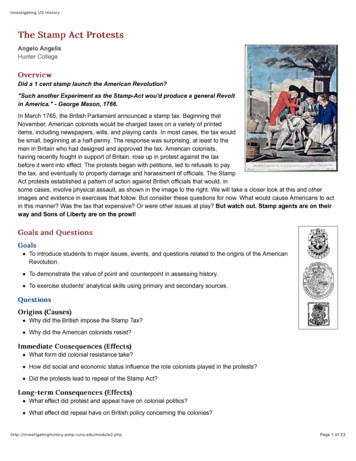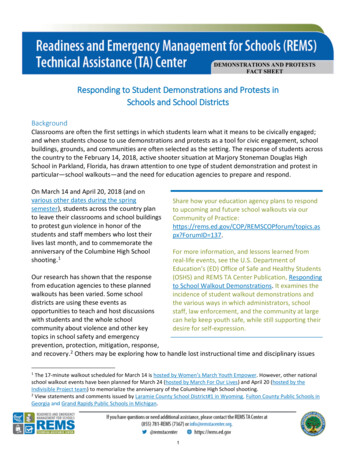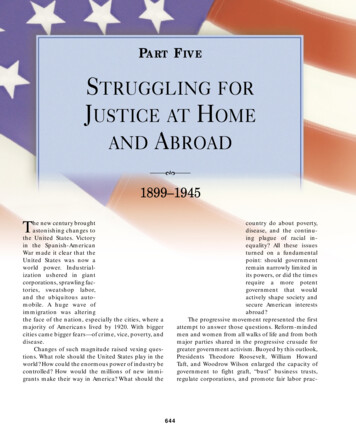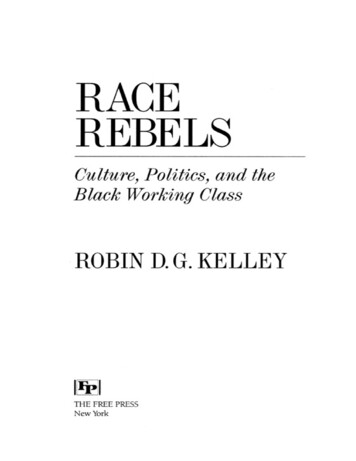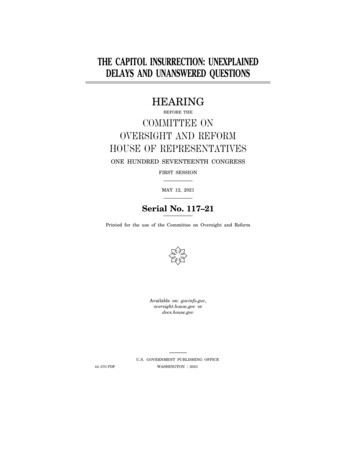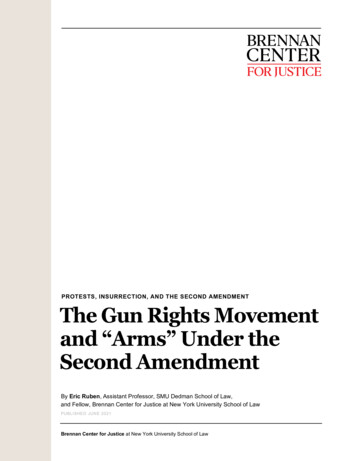
Transcription
PROTESTS, INSURRECTION, AND THE SECOND AMENDMENTThe Gun Rights Movementand “Arms” Under theSecond AmendmentBy Eric Ruben, Assistant Professor, SMU Dedman School of Law,and Fellow, Brennan Center for Justice at New York University School of LawPUBLISHED JUNE 2021Brennan Center for Justice at New York University School of Law
IntroductionAfter Donald Trump supporters breached the U.S. Capitol on January 6 wielding weapons including tasers,chemical sprays, knives, police batons, and baseball bats, Sen. Ron Johnson (R-WI) remarked that theinsurrection “didn’t seem . . . armed.” 1 Johnson, who is A-rated by the National Rifle Association (NRA), 2observed, “When you hear the word ‘armed,’ don’t you think of firearms?” 3 For many, the answer is likelyyes.This essay describes how the gun rights movement has contributed to the conflation of arms and firearms. Indoing so, it shows how that conflation is flatly inconsistent with the most important legal context for arms —the Second Amendment. Neglecting non-gun arms obscures how Americans actually own, carry, and useweapons for self-defense and elevates guns over less lethal alternatives that receive constitutional protectionunder District of Columbia v. Heller. 4 Now is the time to place gun rights into the broader SecondAmendment context, on the eve of the Supreme Court’s next big Second Amendment case, New York StateRifle & Pistol Association v. Corlett. 5Heller’s Definition of Arms andIts Potential ImplicationsThe Second Amendment protects arms, not firearms, 6 and in Heller, the Supreme Court defined an arm as any“[w]eapon[] of offence” or “thing that a man wears for his defence, or takes into his hands,” that is “carr[ied]. . . for the purpose of ‘offensive or defensive action.’” 7 The Court explained that “the Second Amendmentextends, prima facie, to all instruments that constitute bearable arms.” 8 Heller referenced both knives andbows and arrows. 9 Plain meaning and Heller thus point to a Second Amendment that protects much morethan firearms.Courts after Heller acknowledge this result. In 2016, in Caetano v. Massachusetts, every Justice agreed that aMassachusetts court erred when it reasoned that stun guns are not arms. 10 The Supreme Court explained thatHeller both “rejected the proposition that only those weapons useful in warfare are protected” and embracedprotection for weapons “that were not in existence at the time of the founding.” 11 Consistent with both Hellerand Caetano, lower courts have concluded that the Second Amendment also covers knives, tasers, and policebatons. Chemical devices like pepper spray almost surely count too, as — arguably — do lawfully owned objectsnot designed as weapons but possessed or used as them, like many common knives and baseball bats. 12The scale of Second Amendment arms puts firearms into context. To be sure, Americans possess hundreds ofmillions of guns. 13 But researchers trace most firearms to multiple-gun owners, and about half to “superowners” — the 3 percent of the adult population that owns 17 guns on average. 14 Most eligible Americans do notpossess firearms, and the percentage of households that do has dropped in recent decades, according to onecommonly cited survey, from 47 percent in 1980 to 31 percent in 2014. 15 On an individual level, that surveyfound that only 22 percent of American adults own a firearm; 78 percent do not. 16 Far more people own knivesfor the basic reason that they have broader utility in day-to-day life. Some Second Amendment scholars havecalled knives “the most common ‘arm’ in the United States.” 17The decision by most Americans not to own a firearm does not mean that those people don’t care about selfdefense or weapons. Rather, many Americans simply choose not to have a gun. In this regard, as Professors2 Brennan Center for JusticeThe Gun Rights Movement and “Arms” Under the Second Amendment
Philip J. Cook and Kristin A. Goss have observed, “[g]un owners are not a representative sample of theAmerican public.” 18 Polling on non-gun weapons ownership and carrying is underdeveloped (most surveysabout weapons focus solely on guns), but according to at least one poll, women and liberals are much morelikely to carry pepper spray or mace than guns; the opposite is true when isolating for men and conservatives. 19Gun carrying also varies markedly by region — it is more common in the South, for example, than in other partsof the country. 20Meanwhile, data about how self-defense — which Heller called the “core” of the Second Amendment 21 —actually happens on the ground reflects a limited role for guns. Despite exorbitant estimates to the contrary, 22the best evidence suggests that very few self-defense confrontations involve a firearm. According to theNational Crime Victimization Survey, fewer than 1 percent of crime victims report attempting to use a gun inself-defense, and roughly the same percentage report attempting self-defense with another weapon. 23Judges and scholars have yet to fully acknowledge, let alone process, what a holistic assessment of arms andself-defense practices means for the Second Amendment. I address some potential implications elsewhere, 24but for present purposes I briefly summarize here two ways that appreciating the breadth of arms mighttranslate to less constitutional protection for firearms.First, Heller’s essential holding was that private self-defense, and not militia service, is the “core” of the SecondAmendment. 25 Since the time of the Second Amendment’s enactment and before, self-defense law reflects acommitment to shepherding conflicts away from unnecessary lethal violence. 26 For example, the first reportedself-defense case in the United States, State v. Wells, rejected a self-defense claim in part because the defendantchose a weapon — a club — that was unnecessarily lethal in light of equally accessible alternatives. 27 SecondAmendment law arguably should not stray from the law governing its core purpose of self-defense, in whichcase firearm possession and carriage for self-defense might be less constitutionally protected than thepossession and carriage of less lethal arms.Second, Heller suggested that weapon popularity for self-defense is relevant to the constitutional analysis butconcluded that the “American people have considered the handgun to be the quintessential self-defenseweapon” and “the most popular weapon . . . for self-defense in the home.” 28 Available data calls this assertion,which was purely conjectural, into question. If weapon popularity matters for the Second Amendment, thenhandguns — and firearms more generally — may be less protected than Heller suggests.Of course, Second Amendment doctrine is highly contested, and any potential constitutional implications ofarms writ large will be disputed. This brief discussion is neither exhaustive nor conclusive, either in terms oflegal implications or counterarguments. 29 For present purposes, my goal is more modest: first, to establish thatHeller protects more than guns despite the common conflation of “arms” and “firearms,” and second, to suggestthat the breadth of arms arguably should inform how courts implement the Second Amendment.The Gun Rights Movement andthe Popular Conception of Arms“It’s literally in our Constitution for me to be able to own a gun,” a man recently commented when asked aboutrestrictions on firearm possession. 30 Of course, literally the Second Amendment protects the right to keep andbear “arms,” and the Supreme Court in Heller made clear that “arms” is not the same as “firearms.” But despite3 Brennan Center for JusticeThe Gun Rights Movement and “Arms” Under the Second Amendment
that legal understanding, a different process — one in which social contestation can be more important thanjudicial opinions — shapes the popular understanding of arms. And as Professor David Cole observes, the NRAhas “dominated the nation’s debates about gun rights” for decades, 31 and it and other gun rights groupsprominently equate gun rights and arms rights.The NRA holds itself out as a defender of the right to keep and bear arms, but the group’s advocacy focuses onguns, not arms generally. The website for the group’s Civil Rights Defense Fund, for example, notes how it wasformed to “establish[] legal precedents in favor of gun owners.” 32 This should come as no surprise; theorganization is not, after all, the National Arms Association. Another major gun rights group, the SecondAmendment Foundation (SAF), co-opts the Second Amendment in even more transparent form — its veryname. Lest there be doubt, SAF’s mission is to “promot[e] a better understanding about our Constitutionalheritage to privately own and possess firearms.” 33Politicians supported by gun rights groups similarly assume that the Second Amendment is just about guns. Infact, the Republican Party’s official platform conflates gun rights and Second Amendment rights:We uphold the right of individuals to keep and bear arms, a natural inalienable right that predates theConstitution and is secured by the Second Amendment. Lawful gun ownership enables Americans toexercise their God-given right of self-defense for the safety of their homes, their loved ones, and theircommunities. 34Policies endorsed by elected officials thus often invoke the Second Amendment while ignoring non-gunweapons. The “Second Amendment sanctuary” movement is one example. Recently, hundreds of jurisdictionsacross the country have announced themselves to be Second Amendment sanctuaries, 35 vowing to uphold theright to keep and bear arms. Nebraska’s Republican governor declared his entire state a Second Amendmentsanctuary. 36 Texas politicians are attempting to do the same. 37 The status of being a Second Amendmentsanctuary, however, is not about arms generally but about guns specifically. As Texas Governor Greg Abbottexclaimed, it is crucial “to erect a complete barrier against any government office anywhere from treading ongun rights in Texas” because “Second Amendment rights are . . . under attack.” 38 The proposed Texas billnotes that “[t]he Second Amendment to the United States Constitution guarantees the right of the people tokeep and bear arms,” and then goes on to prohibit state and local government officials from enforcing anyfederal law “that purports to regulate a firearm, a firearm accessory, or firearm ammunition.” 39And, similarly, when discussing arms and arms rights in the public square, people frequently assume thatarms equal guns. In June 2020, for example, a couple pointed guns at Black Lives Matter protesters on thesidewalk in front of their home, leading to criminal charges. 40 Thereafter, NRA spokeswoman Dana Loeschinvited the couple onto her podcast, during which one of the gun wielders explained, “We’ve got a right to beararms.” 41 The attorney general of Missouri agreed, complaining that “[c]itizens shouldn’t be targeted forexercising their #2A right to self-defense.” 42 Other commentators and politicians, including then-PresidentTrump, amplified that sentiment. 43 Per usual, no one seemed to consider whether the couple could haveexercised their right to keep and bear arms (or their right to self-defense) with a less lethal weapon than theguns they brandished.On the issue of the public understanding of what counts as an arm, as much as any other, the gun rightsmovement exerts substantial influence. Put simply, “the object of the [Second Amendment] right morphs from‘arms’ into ‘guns.’” 444 Brennan Center for JusticeThe Gun Rights Movement and “Arms” Under the Second Amendment
The Interrelationship of Legal andPopular Conceptions of ArmsThe preceding sections took Heller at its word as demanding a definition of arms uninfluenced by the moderngun rights movement. Justice Antonin Scalia’s majority opinion was celebrated as “the finest example of whatis now called ‘original public meaning’ jurisprudence ever adopted by the Supreme Court.” 45 The opinion setout to discern how the Second Amendment’s text would be understood by “ordinary citizens in the foundinggeneration.” 46 But another interpretation could have profound implications for whether the gun rightsmovement’s influence regarding the popular conception of arms might ultimately bleed into constitutionallaw.Despite Scalia’s professed methodology, we can also understand his opinion for the majority as an example ofthe modern understanding of the right to keep and bear arms, itself heavily influenced by the gun rightsmovement. Shortly after the Court decided Heller, Professor Reva Siegel described how “Heller’s originalismenforces understandings of the Second Amendment that were forged in the late twentieth century throughpopular constitutionalism.” 47 Professor Cole similarly has argued that “the NRA almost certainly had moreresponsibility for the result in Heller than did ‘originalist’ theory.” 48Accounts of the NRA’s and other gun rights groups’ success in changing the Second Amendment narrativebetween the 1970s and Heller amply support these conclusions. The second half of the Second Amendment’s 27words adorns the lobby of the NRA’s headquarters, 49 and beginning in the 1970s, the organization began aremarkable campaign to loosen gun regulations around the country in the name of the right to keep and beararms. Many states amended their constitutions to expand protection of arms rights and passed lawsnormalizing gun carrying as a constitutional right. 50 The NRA rewarded politicians who supported gun rightsand punished those who did not. Meanwhile, the group funded scholarship that “chang[ed] the academiclandscape” by the time the question of whether the Second Amendment protects an individual right reached theSupreme Court. 51 Similarly, “[a]s a result of the NRA’s efforts at the national level, both the executive branchand Congress had endorsed an individual-rights view of the Second Amendment by the time the Supreme Courtaddressed the issue.” 52Those efforts permeate Heller. The historical record did not change in the decades before Heller, and itprovides at best ambiguous support for the majority in any event. 53 But the terms of the popular and legaldebate about the Second Amendment had shifted. In 1991, former Chief Justice Warren Burger called theindividual rights view of the Second Amendment “one of the greatest pieces of fraud, I repeat the word‘fraud,’ on the American public by special interest groups that I’ve ever seen in my lifetime.” 54 By 2008, fraudor no fraud, 73 percent of the American public agreed that the right to keep and bear arms protects anindividual’s right to possess a gun. 55 That year, the individual rights view became the law of the land inHeller.Accounts of the gun rights movement’s influence on the understanding of the Second Amendment frequentlyend with the triumph of the individual rights view in Heller. Yet the social movement conflict did not end in2008; it is now more pronounced than ever. And within that conflict, people overlook the fact that Americansexercise Second Amendment and self-defense rights with non-gun arms. That neglect gets reflected in policiesexpanding gun rights. Furthermore, if Heller’s popular constitutionalism is a guide, the legal understanding of“arms” could follow suit. Indeed, as if anticipating this result, the 1999 edition of Black’s Law Dictionary addedan entry for “right to bear arms”: “The constitutional right of persons to own firearms.” 565 Brennan Center for JusticeThe Gun Rights Movement and “Arms” Under the Second Amendment
ConclusionThe myopic focus on guns in Second Amendment discourse has yet to receive clear endorsement by theSupreme Court, which has recently agreed to hear the next big Second Amendment case, New York State Rifle& Pistol Association v. Corlett. 57 The lead plaintiff in that case is an NRA affiliate and thus the challenged law isa gun law. The risk of concretizing an unduly gun-centric Second Amendment, consistent with the gun rightsmovement’s conception, is as real as ever.At first blush, many people (and especially advocates for nonviolence or gun safety) might balk at thesuggestion that more weapons than guns have Second Amendment status. Endorsing constitutional protectionfor non-guns evokes the melee scenes out of Gangs of New York, 58 not to mention the January 6 armedinsurrection. But privately owned non-gun weapons are almost always less lethal than guns. The U.S. Capitolbreach surely would have been deadlier if the pro-Trump mob carried firearms, which a militia group allegedlystashed at a nearby hotel. 59 It is thus worth considering whether a path to less lethal violence lies in expandingthe conversation beyond guns to the range of less lethal weapons used for self-defense. Unless the public andlegal discourse shifts, policy and constitutional doctrine could be created that assume, as Sen. Johnson did afterthe January 6 insurrection, that firearms are the only arms that matter.Thanks to Joseph Blocher, Susan Liebell, and Darrell Miller for their comments, to Doug Brown for excellentresearch assistance, and to Stephanie Sykes for superb editorial suggestions.6 Brennan Center for JusticeThe Gun Rights Movement and “Arms” Under the Second Amendment
Endnotes1Tim Elfrink, Sen. Ron Johnson Plays Down Capitol Riots: “This Didn’t Seem Like an Armed Insurrection to Me,” WASH. POST (Feb. 16,2021), on-johnson-capitol-riots-downplays.2NRA “A” Rated and Endorsed Ron Johnson, NRA-ILA, https://www.nraila.org/campaigns/2016/ron-johnson (last visited May 13, 2021).3Elfrink, supra note 1.4Dist. of Columbia v. Heller, 554 U.S. 570 (2008).New York State Rifle & Pistol Ass’n v. Corlett, No. 20-843, 2021 WL 1602643 (U.S. Apr. 26, 2021) (granting certiorari on the question“[w]hether the State’s denial of petitioners’ applications for concealed-carry licenses for self-defense violated the Second Amendment”).This essay draws on my research for two longer academic articles. See generally Eric Ruben, An Unstable Core: Self-Defense and theSecond Amendment, 108 CALIF. L. REV. 63, 104 (2020); and Eric Ruben, Law of the Gun: Unrepresentative Cases and Distorted Doctrine,107 IOWA L. REV. (forthcoming 2021).5U.S. CONST. amend. II (“A well-regulated Militia, being necessary to the security of a free State, the right of the people to keep and bearArms shall not be infringed.”).67Heller, 554 U.S. at 581, 584 (quoting framing era dictionaries); id. at 592.8Id. at 582.Id. at 581–82 (citing TIMOTHY CUNNINGHAM, 1 A NEW AND COMPLETE LAW DICTIONARY (1771); JOHN TRUSLER, 1 THE DISTINCTION BETWEENWORDS ESTEEMED SYNONYMOUS IN THE ENGLISH LANGUAGE 37 (3d ed. 1794)); id. at 590 (“Quaker frontiersmen were forbidden to use armsto defend their families,” but must have been tempted on occasion “to seize a hunting rifle or a knife in self-defense” (emphasis added)(quoting PETER BROCK, PACIFISM IN THE UNITED STATES 359 (1968))).910Caetano v. Massachusetts, 577 U.S. 411, 412 (2016) (per curiam).11Id. at 411–12 (quotation marks and citations omitted).12See Ruben, Law of the Gun, supra note 5 (summarizing this case law).Deborah Azrael et al., The Stock and Flow of U.S. Firearms: Results from the 2015 National Firearms Survey, 3 RUSSELL SAGE FOUND. J.SOC. SCI. 38, 54 (2017).13See Lois Beckett, Meet America’s Gun Super-Owners — With an Average of 17 Firearms Each, GUARDIAN (Sept. 20, 2016), n-ownership-america-firearms-super-owners.14See Philip J. Cook & Harold A. Pollack, Reducing Access to Guns by Violent Offenders, 3 RUSSELL SAGE FOUND. J. SOC. SCI. 2, 5 (2017)(citing data from the General Social Survey conducted by the National Opinion Research Center).15Id. These figures remained relatively static through 2018. See TOM W. SMITH & JAESOK SON, TRENDS IN GUN OWNERSHIP IN THEUNITED STATES 1 (2019) (reporting that 34 percent of households and 22 percent of individuals had a firearm in 2018). There has beena surge in gun sales in 2020 and 2021, including among first-time gun owners. See Jaclyn Diaz, 1st-Time Gun Buyers Help PushRecord U.S. Gun Sales Amid String of Mass Shootings, NPR (Apr. 21, 2021), ng-of-mass-shootings. It is too soon to know what impact that trend will have on thesestatistics.16David B. Kopel, Clayton E. Cramer & Joseph Edward Olson, Knives and the Second Amendment, 47 U. MICH. J.L. REFORM 167, 168(2013).1718PHILIP J. COOK & KRISTIN A. GOSS, THE GUN DEBATE: WHAT EVERYONE NEEDS TO KNOW 4 (2020).See CBS News/60 Minutes/Vanity Fair Poll: Genetically Modified Food /Sports/Gun Control, USCBS.201301BVF.Q41 (Dec. 31, 2013)(cross tab).1920Id. I discuss this and other data in greater detail in Ruben, Law of the Gun, supra note 5.21Heller, 554 U.S. at 630.7 Brennan Center for JusticeThe Gun Rights Movement and “Arms” Under the Second Amendment
The darling figure for many gun rights advocates is a quarter-century-old telephone survey that found as many as 2.5 million defensivegun uses annually. See Gary Kleck & Marc Gertz, Armed Resistance to Crime: The Prevalence and Nature of Self-Defense with a Gun, 86J. CRIM. L. & CRIMINOLOGY 150, 164 (1995). But see David Hemenway, Survey Research and Self-Defense Gun Use: An Explanation ofExtreme Overestimates, 87 J. CRIM. L. & CRIMINOLOGY 1430, 1430 (1997) (“The Kleck/Gertz (K-G) paper has now been published. It isclear, however, that its conclusions cannot be accepted as valid.”). Studies over the past several decades have found much more modestestimates.22Between 2007 and 2011, when crime victims were present, they used guns and “other weapons” to threaten or attack a perpetrator inroughly equal proportions, and each in less than 0.9 percent of incidents. David Hemenway & Sara J. Solnick, The Epidemiology of SelfDefense Gun Use: Evidence from the National Crime Victimization Survey, 79 PREVENTIVE MED. 22, 23, 25 tbl. 3b; see also Michael Planty& Jennifer L. Truman, Firearm Violence, 1993–2011, BUREAU OF JUST. STAT. (May 2013), ing that about 44 percent of victims of nonfatal violent crime offered no resistance, 22 percent attacked or threatened without a weapon(e.g., hit or kicked), and 26 percent used nonconfrontational methods (e.g., yelling, running, hiding, or arguing)). For unknown reasons,those who use guns appear to be less likely than those using other weapons to be injured before their gun use, but there is no meaningfuldifference between guns and other weapons in the likelihood of an injury during or after weapons use. Hemenway & Solnick, supra, at 25–26. Likewise, in property crimes, there is little difference in whether property is ultimately taken when a gun is used defensively (38.5percent) as opposed to when another weapon is used defensively (34.9 percent). Id. at 26.2324See supra note 5.25Heller, 554 U.S. at 595, 630.26Ruben, An Unstable Core, supra note 5, at 104.27See State v. Wells, 1 N.J.L. 424, 426 (N.J. 1790).28Heller, 554 U.S. at 629.29I discuss other implications of a broader appreciation of arms in Ruben, Law of the Gun, supra note 5.Rebekah Allen & James Barragán, Will Texans Give Up Gun Rights to Get Medical Marijuana? Federal Government Says They HaveTo, DALLAS MORNING NEWS (June 17, 2019), VID D. COLE, ENGINES OF LIBERTY: THE POWER OF CITIZEN ACTIVISTS TO MAKE CONSTITUTIONAL LAW 103 (2016).NRA CIVIL RIGHTS DEFENSE FUND, LEGAL & FINANCIAL ASSISTANCE, https://www.nradefensefund.org/about-us.aspx (last visited May 14,2021) (“The NRA Civil Rights Defense Fund was established by the NRA Board of Directors in 1978 to become involved in court casesestablishing legal precedents in favor of gun owners.”).3233Mission Statement, SECOND AMENDMENT FOUND., https://www.saf.org/mission.REPUBLICAN NAT’L CONVENTION, REPUBLICAN PARTY PLATFORM OF 2016, at 12 (emphasis added), https://prod-cdn-static.gop.com/docs/Resolution Platform 2020.pdf; see also Reva B. Siegel, Dead or Alive: Originalism as Popular Constitutionalism in Heller, 122 HARV. L.REV. 191, 212–15 (2008) (showing how the shift on guns within the Republican Party was motivated by a coalition of gun rightsadvocates).34See, e.g., Jeff Williamson, List of Second Amendment Sanctuaries in Virginia and Where It’s Being Discussed, WSLS (updated Aug. 11,2020), e-its-being-discussed.35Jordan Williams, Gov. Ricketts Declares Nebraska a “Second Amendment Sanctuary State,” HILL (Apr. 14, 2021), nctuary-state.36Press Release, Office of the Texas Governor, Governor Abbott Delivers 2021 State of the State Address (Feb. 1, 2021), livers-2021-state-of-the-state-address.3738Id. (emphasis added).39H.B. No. 112, 87th Leg. (Tex. 2021), /HB00112I.pdf#navpanes 0.Teo Armus & Kim Bellware, St. Louis Couple Point Guns at Crowd of Protesters Calling for Mayor to Resign, WASH. POST (June 29,2020), t-louis-protest-gun-mayor.4041The Dana Show, Tuesday July 28 — Full Show (July 28, 2020), pod-full 1.8 Brennan Center for JusticeThe Gun Rights Movement and “Arms” Under the Second Amendment
42Eric Schmitt (@Eric Schmitt), TWITTER (July 20, 2020, 6:07 PM), https://twitter.com/Eric Schmitt/status/1285350569977274369.43William Cummings, “An Outrageous Abuse of Power”: Republicans Decry Prosecution of McCloskeys, Who Trained Guns on Protesters,USA TODAY (July 21, 2020), ccloskey-st-louis/5479005002.44MARY ANNE FRANKS, THE CULT OF THE CONSTITUTION: OUR DEADLY DEVOTION TO GUNS AND FREE SPEECH 70 (2019).Randy E. Barnett, Opinion, News Flash: The Constitution Means What It Says, WALL ST. J. (June 27, 09067.4546Heller, 554 U.S. at 577.Siegel, supra note 34, at 192; see also id. at 195–201 (recounting “temporal oddities” in Heller — how the Court used authority fromvarious time periods to support its conclusions about the original understanding of the text of the Second Amendment).4748See COLE, supra note 31, at 99.Michael Waldman, How the NRA Rewrote the Second Amendment, POLITICO MAG. (May 19, /05/nra-guns-second-amendment-106856.49The NRA and other gun rights advocates call carrying a handgun without a permit “constitutional carry.” See, e.g., Constitutional CarryPasses in Montana, NRA-ILA (Feb. 18, 2021), ional-carry-passes-in-montana.5051COLE, supra note 31, at 119.52Id. at 131.The four dissenting judges in Heller, considering the same historical record as the majority, were barely edged out about theconstitutionality of the District of Columbia’s handgun ban. Historians filed amicus briefs in support of both sides. And recent researchdeploying corpus linguistics — searching large, electronic collections of text to determine legal meaning — calls into question Heller’sarticulation of the meaning of “to keep and bear arms.” See, e.g., Alison L. LaCroix, Historical Semantics and the Meaning of the SecondAmendment, PANORAMA (Aug. 3, 2018), 53Warren E. Burger, The Right to Bear Arms, PARADE MAG., 4 (Jan. 14, 1990) (quoted in Silveira v. Lockyer, 312 F.3d 1052, 1063 (9th Cir.2002)).54Jeffrey M. Jones, Americans in Agreement with Supreme Court on Gun Rights, GALLUP (June 26, t to Bear Arms, BLACK’S LAW DICTIONARY 1326 (7th ed. 1999). The same definition appears in subsequent editions.57New York State Rifle & Pistol Ass’n v. Corlett, No. 20-843, 2021 WL 1602643 (U.S. Apr. 26, 2021).58GANGS OF NEW YORK (Miramax 2002).Kyle Cheney, Prosecutors: Oath Keepers Appeared to Stash Jan. 6 Firearms at Suburban Comfort Inn, POLITICO (Apr. 13, secutors-oath-keepers-comfort-inn-481098.599 Brennan Center for JusticeThe Gun Rights Movement and “Arms” Under the Second Amendment
5 Brennan Center for Justice The Gun Rights Movement and "Arms" Under the Second Amendment The Interrelationship of Legal and Popular Conceptions of Arms The preceding sections took Heller at its word as demanding a definition of arms uninfluenced by the modern gun rights movement. Justice Antonin Scalia's majority opinion was celebrated as "the finest example of what


